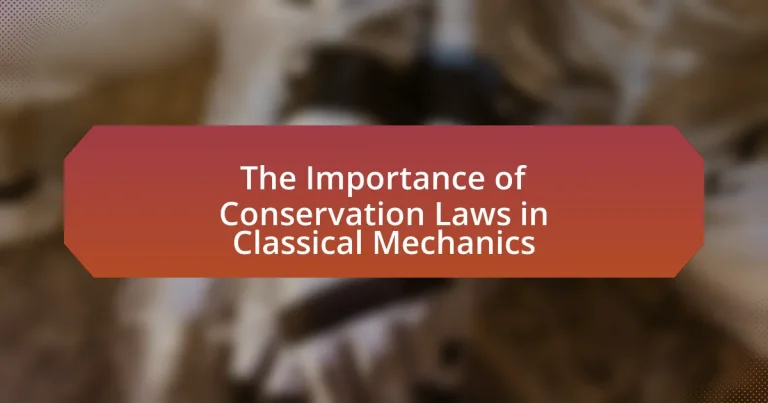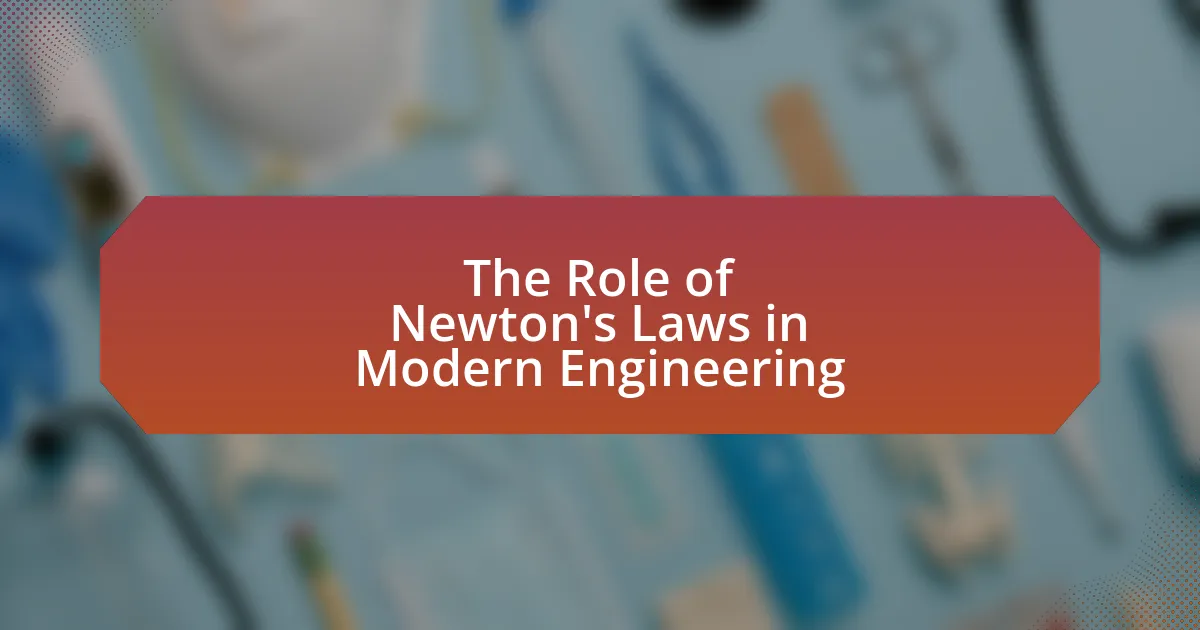Conservation laws in classical mechanics are essential principles that state certain physical quantities, such as energy, momentum, and angular momentum, remain constant in isolated systems over time. These laws are fundamental for predicting the behavior of physical systems, allowing for the analysis of mechanical interactions without needing detailed knowledge of the forces involved. The article explores the significance of these laws, their applications in real-world scenarios, and their role in engineering and scientific research, emphasizing how they enhance safety, efficiency, and understanding in various fields. Additionally, it discusses strategies for effectively applying conservation laws in problem-solving and highlights resources for further study.

What are Conservation Laws in Classical Mechanics?
Conservation laws in classical mechanics are fundamental principles stating that certain physical quantities remain constant in isolated systems over time. These laws include the conservation of energy, momentum, and angular momentum, which dictate that energy cannot be created or destroyed, the total momentum of a closed system remains unchanged, and the total angular momentum remains constant unless acted upon by an external torque. These principles are validated through numerous experiments and observations, such as the predictable outcomes in collisions and the stability of planetary orbits, demonstrating their critical role in understanding and analyzing physical systems.
Why are Conservation Laws fundamental to Classical Mechanics?
Conservation laws are fundamental to classical mechanics because they provide essential principles that govern the behavior of physical systems. These laws, such as the conservation of energy, momentum, and angular momentum, allow for the prediction of system behavior over time without needing to know the detailed forces acting on the system. For instance, the conservation of energy states that in an isolated system, the total energy remains constant, which is a foundational concept used to analyze mechanical systems and solve problems in physics. This principle has been validated through numerous experiments and applications, such as in the design of engines and the analysis of collisions, demonstrating its critical role in understanding and applying classical mechanics.
What are the key types of Conservation Laws?
The key types of Conservation Laws in classical mechanics are the Conservation of Energy, Conservation of Momentum, and Conservation of Angular Momentum. The Conservation of Energy states that the total energy in an isolated system remains constant over time, as demonstrated by the first law of thermodynamics. The Conservation of Momentum asserts that the total momentum of a closed system is constant if no external forces act upon it, which is evident in collisions where momentum before and after remains equal. The Conservation of Angular Momentum indicates that the total angular momentum of a system remains constant if no external torque is applied, a principle observable in rotating systems like planets and spinning tops. These laws are foundational in understanding physical interactions and predict the behavior of systems in motion.
How do Conservation Laws relate to physical systems?
Conservation laws are fundamental principles that describe the behavior of physical systems by stating that certain quantities remain constant over time. For example, the law of conservation of energy asserts that the total energy in an isolated system remains unchanged, which is crucial for analyzing mechanical systems, thermodynamics, and various physical processes. This principle is validated by numerous experiments, such as those demonstrating that energy can transform from one form to another but cannot be created or destroyed, as shown in the work of scientists like James Joule in the 19th century. Similarly, conservation of momentum indicates that the total momentum of a closed system remains constant, a concept that is essential in collision analysis and is supported by empirical evidence from particle physics experiments. Thus, conservation laws provide a framework for understanding and predicting the behavior of physical systems across various contexts in classical mechanics.
How do Conservation Laws influence the behavior of physical systems?
Conservation laws, such as the conservation of energy, momentum, and angular momentum, fundamentally dictate the behavior of physical systems by establishing that certain quantities remain constant in isolated systems. For instance, the conservation of energy states that the total energy in a closed system cannot change; it can only transform from one form to another, which governs how systems evolve over time. This principle is evidenced in mechanical systems where potential energy converts to kinetic energy during motion, illustrating that energy is conserved throughout the process. Similarly, the conservation of momentum asserts that the total momentum of a system remains constant unless acted upon by an external force, which is observable in collisions where the momentum before and after the event remains equal. These laws provide a framework for predicting the outcomes of physical interactions, making them essential for understanding and analyzing classical mechanics.
What role does energy conservation play in mechanics?
Energy conservation is fundamental in mechanics as it states that the total energy of an isolated system remains constant over time. This principle allows for the analysis of mechanical systems by equating potential energy and kinetic energy, facilitating the prediction of system behavior during interactions. For instance, in a closed system, the work done by external forces can be calculated by considering the changes in kinetic and potential energy, as expressed in the work-energy theorem. This theorem is validated by numerous experiments and applications, such as the conservation of mechanical energy in pendulums and roller coasters, where energy transformations occur without loss to external forces.
How does momentum conservation affect collisions?
Momentum conservation dictates that in a closed system, the total momentum before a collision equals the total momentum after the collision. This principle is fundamental in analyzing collisions, as it allows for the prediction of the resulting velocities of colliding objects based on their initial velocities and masses. For example, in elastic collisions, both momentum and kinetic energy are conserved, while in inelastic collisions, momentum is conserved but kinetic energy is not. The validity of momentum conservation is supported by experimental evidence, such as the consistent results observed in laboratory collision experiments, confirming that the total momentum remains constant in isolated systems.

What are the implications of Conservation Laws in real-world applications?
Conservation laws, such as the conservation of energy, momentum, and mass, have significant implications in real-world applications, influencing fields like engineering, physics, and environmental science. For instance, the conservation of energy principle is fundamental in designing efficient engines and power plants, ensuring that energy input is effectively converted to useful work, as demonstrated by the efficiency calculations in thermodynamic cycles. Additionally, the conservation of momentum is crucial in collision analysis, allowing engineers to predict outcomes in vehicle crashes, which is essential for safety regulations and vehicle design. Furthermore, in environmental science, the conservation of mass is applied in modeling pollutant dispersion, aiding in the development of strategies to minimize environmental impact. These laws provide a framework for understanding and predicting physical phenomena, thereby enhancing technological advancements and promoting sustainable practices.
How do Conservation Laws apply to engineering and technology?
Conservation laws, such as the conservation of mass, energy, and momentum, are fundamental principles that guide engineering and technology by ensuring that systems behave predictably and efficiently. In engineering, these laws are applied to design processes, such as in fluid dynamics where the conservation of mass is crucial for calculating flow rates in pipelines. For example, the continuity equation, derived from the conservation of mass, is essential in predicting how fluids move through various systems.
In technology, conservation laws underpin the development of energy-efficient devices. The first law of thermodynamics, which states that energy cannot be created or destroyed, is applied in designing engines and power plants to maximize energy conversion efficiency. Historical advancements, such as the development of the steam engine, relied on these principles to improve performance and reduce waste.
Overall, conservation laws provide a framework that engineers and technologists use to innovate and optimize systems, ensuring that resources are utilized effectively while adhering to physical principles.
What examples illustrate the application of Conservation Laws in engineering?
Conservation laws are fundamental principles in engineering, exemplified by the conservation of energy in mechanical systems, where energy is neither created nor destroyed but transformed from one form to another. For instance, in a roller coaster, gravitational potential energy converts to kinetic energy as the coaster descends, illustrating energy conservation. Another example is the conservation of momentum in vehicle collisions, where the total momentum before and after the collision remains constant, demonstrating how momentum conservation is applied in crash safety designs. Additionally, the conservation of mass is evident in chemical engineering processes, such as in reactors where the mass of reactants equals the mass of products, ensuring efficient material usage. These examples validate the critical role of conservation laws in engineering design and analysis.
How do these laws enhance safety and efficiency in design?
Conservation laws enhance safety and efficiency in design by ensuring predictable behavior of physical systems, which allows engineers to create structures and mechanisms that can withstand expected forces and conditions. For instance, the law of conservation of energy dictates that energy cannot be created or destroyed, guiding designers to optimize energy use in systems, thereby reducing waste and improving efficiency. Additionally, the law of conservation of momentum helps in predicting the outcomes of collisions, which is crucial in automotive and aerospace design to enhance safety features like crumple zones and airbag deployment systems. These laws provide a foundational framework that informs design decisions, ultimately leading to safer and more efficient products.
What is the significance of Conservation Laws in scientific research?
Conservation laws are fundamental principles in scientific research that dictate the constancy of certain physical quantities in isolated systems. These laws, such as the conservation of energy, momentum, and angular momentum, provide a framework for understanding and predicting the behavior of physical systems. For instance, the law of conservation of energy states that energy cannot be created or destroyed, only transformed, which is crucial for analyzing mechanical systems and thermodynamics. This principle has been validated through numerous experiments and applications, such as in the design of engines and the study of collisions in particle physics, demonstrating its essential role in advancing scientific knowledge and technology.
How do Conservation Laws guide experimental physics?
Conservation laws guide experimental physics by providing fundamental principles that dictate the behavior of physical systems. These laws, such as the conservation of energy, momentum, and angular momentum, serve as essential frameworks for predicting outcomes in experiments. For instance, the conservation of momentum allows physicists to analyze collisions and interactions between particles, ensuring that the total momentum before and after an event remains constant. This principle has been validated through numerous experiments, including those in particle physics, where the outcomes align with theoretical predictions based on conservation laws. Thus, conservation laws not only inform the design of experiments but also validate the results, reinforcing their critical role in the field of experimental physics.
What insights do Conservation Laws provide in theoretical studies?
Conservation laws provide fundamental insights into the behavior of physical systems in theoretical studies by establishing principles that remain constant over time, such as energy, momentum, and angular momentum. These laws allow physicists to predict the outcomes of interactions and transformations within a system, leading to a deeper understanding of dynamics and stability. For instance, the law of conservation of energy states that the total energy in an isolated system remains constant, which is crucial for analyzing mechanical systems and solving problems in classical mechanics. This principle has been validated through numerous experiments and applications, such as in the design of engines and the analysis of collisions, demonstrating its reliability and significance in theoretical frameworks.

How can one effectively apply Conservation Laws in problem-solving?
One can effectively apply Conservation Laws in problem-solving by identifying the relevant conservation principle, such as conservation of energy, momentum, or mass, and using it to simplify the analysis of a physical system. For instance, in a collision problem, one can apply the conservation of momentum to relate the velocities of colliding objects before and after the event, allowing for the calculation of unknown quantities. This method is validated by the fact that these laws are derived from fundamental principles of physics and have been consistently observed in experimental settings, such as the conservation of momentum being confirmed in various collision experiments.
What strategies can be used to apply Conservation Laws in mechanics problems?
To apply Conservation Laws in mechanics problems, one effective strategy is to identify the relevant conservation principle, such as conservation of energy, momentum, or angular momentum, based on the specific scenario. For instance, in a closed system where no external forces act, the total momentum before an event (like a collision) equals the total momentum after the event. This principle can be mathematically expressed as m1v1 + m2v2 = m1v1′ + m2v2′, where m represents mass and v represents velocity. Additionally, analyzing the system’s boundaries helps in determining which quantities remain constant, allowing for simplifications in calculations. This approach is validated by numerous physics problems where applying these conservation laws leads to accurate predictions of outcomes, demonstrating their fundamental role in classical mechanics.
How can one identify which Conservation Law to use in a given scenario?
To identify which Conservation Law to use in a given scenario, one must analyze the system’s characteristics and the forces acting upon it. For instance, if no external forces are acting on a closed system, the Conservation of Momentum applies; if the system is isolated and experiences no net external work, the Conservation of Energy is relevant. Additionally, if the system’s shape or configuration changes without external influence, the Conservation of Angular Momentum is applicable. These laws are validated by empirical observations in physics, such as experiments demonstrating momentum conservation in collisions and energy conservation in isolated systems.
What common mistakes should be avoided when applying these laws?
Common mistakes to avoid when applying conservation laws in classical mechanics include neglecting the system boundaries, misapplying the laws to non-isolated systems, and failing to account for external forces. Neglecting system boundaries can lead to incorrect conclusions about energy or momentum conservation, as the laws only apply within defined limits. Misapplying conservation laws to non-isolated systems, where external forces act, can result in inaccurate calculations, as these forces can change the total energy or momentum. Additionally, failing to account for external forces can lead to erroneous results, as these forces can significantly impact the system’s behavior.
What resources are available for further understanding of Conservation Laws?
Key resources for further understanding of Conservation Laws include textbooks, academic journals, and online courses. Textbooks such as “Classical Mechanics” by Herbert Goldstein provide foundational knowledge and detailed explanations of conservation principles. Academic journals like the “American Journal of Physics” publish peer-reviewed articles that explore advanced topics and recent research related to conservation laws. Online platforms such as Coursera and edX offer courses from universities that cover classical mechanics and conservation laws, allowing for interactive learning and practical applications. These resources collectively enhance comprehension of the significance and applications of conservation laws in classical mechanics.
What textbooks or online courses are recommended for studying Conservation Laws?
Recommended textbooks for studying Conservation Laws include “Classical Mechanics” by Herbert Goldstein, which provides a comprehensive overview of the principles and applications of conservation laws in mechanics. Another key resource is “Mechanics” by L.D. Landau and E.M. Lifshitz, which offers in-depth discussions on conservation principles. For online courses, the Massachusetts Institute of Technology (MIT) offers a free course titled “Classical Mechanics,” which covers conservation laws extensively. Additionally, Coursera features courses on classical mechanics that include modules specifically focused on conservation laws. These resources are widely recognized in the academic community for their thorough treatment of the subject.
How can simulations and software aid in understanding these concepts?
Simulations and software can significantly enhance the understanding of conservation laws in classical mechanics by providing interactive visualizations and real-time data analysis. These tools allow users to model physical systems, observe the effects of various forces, and analyze the outcomes based on conservation principles such as energy, momentum, and angular momentum. For instance, software like PhET Interactive Simulations enables users to manipulate variables in a controlled environment, demonstrating how conservation laws apply in different scenarios, such as collisions or projectile motion. Research has shown that students using simulations perform better in understanding these concepts compared to traditional methods, as evidenced by a study published in the Journal of Educational Psychology, which found that interactive simulations improved conceptual understanding by 30% among high school students.




